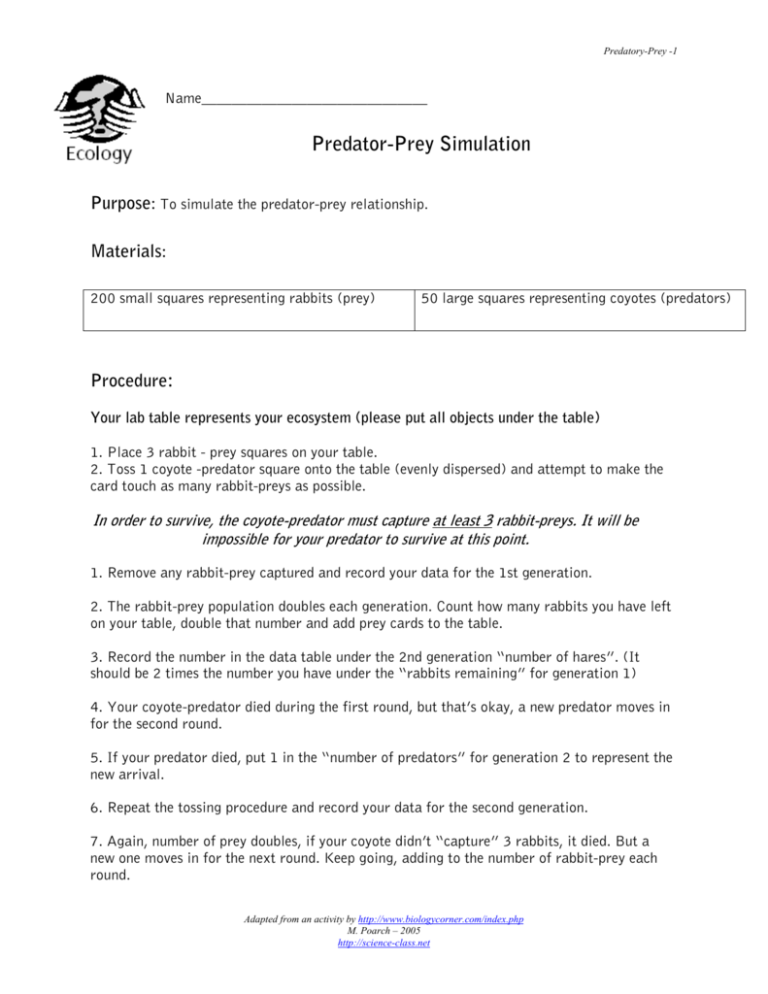Predator-Prey Simulation
advertisement

Predatory-Prey -1 Name______________________________ Predator-Prey Simulation Purpose: To simulate the predator-prey relationship. Materials: 200 small squares representing rabbits (prey) 50 large squares representing coyotes (predators) Procedure: Your lab table represents your ecosystem (please put all objects under the table) 1. Place 3 rabbit - prey squares on your table. 2. Toss 1 coyote -predator square onto the table (evenly dispersed) and attempt to make the card touch as many rabbit-preys as possible. In order to survive, the coyote-predator must capture at least 3 rabbit-preys. It will be impossible for your predator to survive at this point. 1. Remove any rabbit-prey captured and record your data for the 1st generation. 2. The rabbit-prey population doubles each generation. Count how many rabbits you have left on your table, double that number and add prey cards to the table. 3. Record the number in the data table under the 2nd generation “number of hares”. (It should be 2 times the number you have under the “rabbits remaining” for generation 1) 4. Your coyote-predator died during the first round, but that’s okay, a new predator moves in for the second round. 5. If your predator died, put 1 in the “number of predators” for generation 2 to represent the new arrival. 6. Repeat the tossing procedure and record your data for the second generation. 7. Again, number of prey doubles, if your coyote didn’t “capture” 3 rabbits, it died. But a new one moves in for the next round. Keep going, adding to the number of rabbit-prey each round. Adapted from an activity by http://www.biologycorner.com/index.php M. Poarch – 2005 http://science-class.net Predatory-Prey -2 8. Eventually your predator will be able to capture enough prey to survive. Guess what happens? The number of predators doubles. Add to your predator population by adding predator cards. Now when you toss your predators, you will be tossing more than one. Don’t forget to remove any “captured” prey. 9. Continue to record the data through 20 generations. Data: Generations # of predators # of prey # of predators remaining 1 2 3 4 5 6 7 8 9 10 11 12 13 14 15 16 17 18 19 20 Adapted from an activity by http://www.biologycorner.com/index.php M. Poarch – 2005 http://science-class.net # of prey remaining Predatory-Prey -3 Data Analysis: Graph your data. Make a double line graph. Remember TAILS & DRY MIX. On the X-axis, put generations 1 through 20. Why? _________________________ On the Y-axis you will have the population numbers for each generation (number of predators, number of prey). Why? ______________________________ Use one line for the predator and one line for the prey to graph the data. Adapted from an activity by http://www.biologycorner.com/index.php M. Poarch – 2005 http://science-class.net Predatory-Prey -4 Describe the relationship between the variables: ______________________________________________________________________________ ______________________________________________________________________________ ______________________________________________________________________________ ______________________________________________________________________________ ______________________________________________________________________________ Conclusions: What inferences about the predator – prey relationship can you make based on this data? ______________________________________________________________________________ ______________________________________________________________________________ ______________________________________________________________________________ ______________________________________________________________________________ ______________________________________________________________________________ Adapted from an activity by http://www.biologycorner.com/index.php M. Poarch – 2005 http://science-class.net









